Archive for December, 2018
UT blue light research named a Top 100 science paper of 2018
Friday, December 21st, 2018A scientific discovery at The University of Toledo was selected as one of the top 100 most talked about scholarly publications in the world this year.
Altmetric, a data company that tracks and tallies the year’s 100 most attention-grabbing studies, chose UT’s blue light research as No. 76 in its annual list that provides a picture of the influence and reach of academic work.
According to Altmetric’s analysis, “The blue light coming from your computers, phones and tablets is doing damage to your retinas, and this study elaborates on the mechanisms by which blue light causes retinal degradation. The study has elicited a lot of interest, concern and conflicting advice across popular media about how best to protect your eyes.”
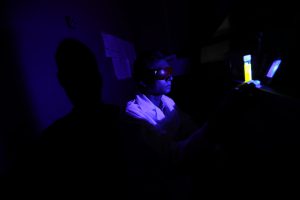
Dr. Ajith Karunarathne examined toxic oxygen generation by retinal during blue light exposure.
Dr. Ajith Karunarathne, assistant professor in the Department of Chemistry and Biochemistry, earned international attention in August for discovering how blue light triggers cell death in the presence of retinal, a light harvesting molecule in the eye.
His research about blue light-induced cell damage reached more than 400 million people around the world through hundreds of news outlets, including Popular Science, USA Today, CNN Headline News/HLN, The Guardian, Teen Vogue, Forbes and Newsweek.
Altmetric not only tracks news media mentions, but also social media shares and policy documents. Overall, the company tracked more than 25 million mentions of 2.8 million research outputs in 2018.
In its demographic breakdown of the blue light research, Altmetric shows that while scientists and physicians shared UT’s news on Twitter, most of the tweets – 84 percent – came from members of the public.
“My group is composed of extremely talented and hardworking graduate and undergraduate students, and this recognition is a tribute to their passion in advancing science,” Karunarathne said. “Our published work is an example of how multidisciplinary research can unveil hidden molecular details of crucial cellular mechanisms.”
In this case, UT chemists explored how the combination of blue light and retinal – the abundant chromophore in the eye – damages cells.
Karunarathne’s lab found that blue light exposure causes retinal to trigger reactions that generate poisonous chemical molecules in photoreceptor cells.
After his research showing retinal-generated toxicity by blue light was published in the journal Scientific Reports in July, Karunarathne said he received feedback from people who shared their experiences on how occupational blue light exposure is a major health concern for them.
“It is an honor to study a process that people care so much about,” Karunarathne said. “In this high-tech world, we are being exposed to blue light continuously. It is crucial to find how and when blue light becomes damaging.”
Karunarathne’s lab currently is measuring light coming from television, cell phone and tablet screens to get a better understanding of how the cells derived from the eye respond to everyday blue light exposure.
“We are looking into the details of the discovered mechanism and investigating if commonly used light-emitting devices have the potential to trigger toxic chemical reactions in cells,” Karunarathne said.
UT engineering professors’ invention named to prestigious R&D Top 100 list
Monday, December 17th, 2018A synthetic bone graft substitute developed at The University of Toledo has been recognized by R&D Magazine as one of the year’s most exceptional innovations in science and technology.
Created by Dr. Sarit Bhaduri, Distinguished University Professor of Mechanical, Industrial and Manufacturing Engineering at UT, NovoGro is a moldable bone substitute putty used to fill gaps in bone and encourage new bone growth. It is used primarily in complicated fractures that would not otherwise heal properly on their own.
“Our composition is innovative and quite different from any of our well-known competitors,” Bhaduri said. “The response of bone growth is much faster than other products that are currently available. Our product also incorporates innovative processing techniques that simplify production, which further sets it apart.”
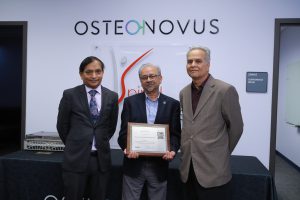
Dr. Anand Agarwal, left, Dr. Sarit Bhaduri, center, and Dr. Vijay K. Goel display the R&D 100 award. The three incorporated a biomedical company to commercialize Bhaduri’s invention.
R&D Magazine has annually selected the top 100 revolutionary technologies of the past year since 1963. Among this year’s other winners were Dow Chemical, Texas Instruments, the MIT Lincoln Laboratory, Oak Ridge National Laboratory and NASA’s Glenn Research Center.
“The R&D 100 Award is one of the most prestigious recognitions in applied science,” UT Vice President for Research Frank Calzonetti said. “This award speaks to the ability of Bhaduri and his University of Toledo colleagues in translating highest quality research into marketable products to improve the health outcomes of many.”
Bhaduri teamed up with Dr. Vijay K. Goel, UT Distinguished University Professor and Endowed Chair and McMaster-Gardner Professor of Orthopaedic Bioengineering, and Dr. Anand Agarwal, UT research professor of bioengineering, to license the technology from the University and co-found the biomedical firm OsteoNovus Inc. Agarwal also serves as the president and chief executive officer of OsteoNovus, where the product has undergone further development.
“In this category of orthobiologics — how to grow bone — there are many players, but the problem is the big guys aren’t doing much innovation,” Bhaduri said. “We wanted to disrupt that.”
The U.S. Food and Drug Administration has cleared NovoGro for use in two different indications — spine and the extremities.
Currently, NovoGro has a half dozen clinical users across the country and is trying to grow the client base significantly in 2019.
The company’s corporate offices and manufacturing facility is housed within The University of Toledo LaunchPad Incubation Program.
Professor awarded $2.1 million NIH grant to study fungal infection common in cancer patients
Wednesday, December 12th, 2018A University of Toledo scientist has been awarded a $2.1 million National Institutes of Health grant to continue her research into one of the most common and debilitating conditions experienced by patients undergoing treatment for head or neck cancers.
Dr. Heather Conti, UT assistant professor of biological sciences, studies a fungal infection called oral candidiasis. The infection is more commonly known as thrush.
In otherwise healthy individuals the condition is minor, but for those with compromised immune systems or undergoing radiation or chemotherapy, oral candidiasis can turn into a serious and potentially dangerous illness.
“Unfortunately, many patients who develop this condition choose to forego their cancer treatment,” Conti said. “It can actually have a direct link to cancer prognosis because the symptoms are too hard to deal with.”
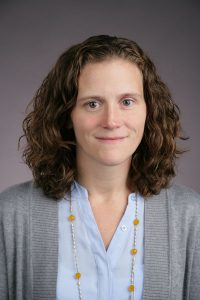
Dr. Heather Conti
The five-year grant, which is distributed through the National Institute of Dental and Craniofacial Research, will fund research into the role blood platelets play in the body’s natural defense against oral candidiasis.
“Platelets are commonly thought of for their role in blood clotting. But what we’re finding more and more is that platelets also play a very important role in the immune response,” Conti said. “They can protect against various bacteria — or in our case, fungi — which is a novel thought in the field. Platelets can be a much more complicated cell than just taking part in blood clotting.”
She is collaborating with Dr. Randall Worth, associate professor of medical microbiology and immunology at UT, on the project.
The reason oral candidiasis can cause such serious problems in cancer patients is the fact that chemotherapy and radiation often destroy the mucous membrane in the mouth, allowing the fungi to grow unchecked. That, Conti said, can lead to sores on the gums or tongue, difficulty swallowing, bleeding and pain. If the fungal infection reaches the bloodstream and spreads throughout the body, it can become life threatening.
Patients with HIV are also at greater risk of serious infection from oral candidiasis.
Candidiasis can be successfully treated with antifungal medications, but Conti said there is an emerging trend of strains that have developed resistance to commonly prescribed drugs. That limits clinicians’ options, particularly in individuals who are already in poor health.
The goal of this research, Conti said, is better understanding how the body fights the infection and how we might be able to leverage that response to formulate new treatments.
“The immune response to oral candidiasis is quite complicated. If platelets play an important role, we need to understand that response. The hope would be to develop therapeutics that not only kill the fungus directly but can also bolster the immune response,” she said.
UT engineers create method to save at least $120,000 per mile on road pavement projects
Tuesday, December 11th, 2018Before orange construction barrels dot pot-holed streets or highways, a vital part of planning a pavement project is determining how thick the next layer of asphalt needs to be, taking into consideration the layers that already lie beneath the surface.
A team of engineers at The University of Toledo created a new procedure and design software to more accurately estimate the structural capacity of existing pavement that could save the Ohio Department of Transportation millions of dollars on road improvement projects and be adopted by states across the U.S.
The Transportation Research Board, a unit of the National Academies of Sciences, Engineering and Medicine, selected UT’s project for developing a revised pavement overlay thickness design procedure as one of 32 High Value Research projects nationwide to be highlighted at its annual meeting January 13-17 in Washington, D.C., which attracts 13,000 transportation professionals from around the world.
The new method is specifically designed for composite pavement – concrete pavement already topped with a thick layer of asphalt – which accounts for the majority of ODOT’s four-lane and interstate highways. Previously, ODOT used a design method that was originally developed for rigid, concrete pavements that tended to produce designs often deemed too thick and wasteful for today’s roadways, as pavement becomes thicker with each additional overlay.
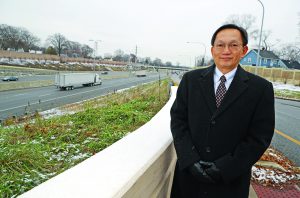
Dr. Eddie Chou
For an update, ODOT turned to the engineer who crafted the original design 25 years ago: Dr. Eddie Chou, UT professor of civil and environmental engineering and director of the Transportation Systems Research Lab.
“The previous procedure did not work well with thick composite pavement. With this particular type of road, it tended to underestimate the existing structure’s worth,” said Chou, who worked on the project with Dr. Liango Hu, UT associate professor of civil and environmental engineering. “Many existing pavement sections we examined now require several inches thinner than previously demanded to withstand traffic for an additional 20-to-25 years.”
The UT research team adopted a three-layer model for back calculating the properties of the soil subgrade and pavement layers, instead of the old two-layer model that combined cement and asphalt into one.
Chou said the new design reduces on average about five inches of overlay thickness, and the reduction of each additional inch of overlay can save approximately $120,000 per mile.
“In addition to being more environmentally friendly, the potential cost savings can be substantial considering each year ODOT rehabilitates several hundred miles of existing composite pavements by laying additional asphalt on top,” Chou said.
The revised design procedure was implemented into design software that adopts the improved back-calculation model. The software also offers an optional feature that takes into consideration the effects of temperature.
The Ohio Department of Transportation and Federal Highway Administration sponsored the UT research.
“This UT research developed a revised rehabilitation design procedure for composite pavement structures in Ohio and more accurately characterizes pavement layers for this analysis,” Patrick Bierl, pavement design engineer and pavement rating coordinator in ODOT’s Office of Pavement Engineering, said. “This revised procedure allows ODOT to continue to produce efficient and cost-effective rehabilitation designs to manage our composite pavements.”
December UT Board of Trustees Meetings
Tuesday, December 11th, 2018BOARD OF TRUSTEES MEETINGS
Sunday, December 16, 2018
Driscoll Alumni Center, Schmakel Room
5:30 p.m. Board of Trustees Dinner
Monday, December 17, 2018
Driscoll Alumni Center, Schmakel Room
12:30 p.m. Clinical Affairs Committee Meeting
1 p.m. Academic and Student Affairs Committee Meeting
1:15 p.m. Finance and Audit Committee Meeting
1:30 p.m. Trusteeship and Governance Committee Meeting
1:45 p.m. Board of Trustees Meeting
A luncheon for the trustees will be held at noon in the Driscoll Alumni Center Board Room.
Any questions may be directed to the Office of University Communications by calling 419.530.2410 or via email to meghan.cunningham@utoledo.edu.
UT engineering students to show off senior design projects Dec. 7
Thursday, December 6th, 2018From bio-fuels to a collapsible wind turbine, dozens of senior design projects will be on display from noon to 3 p.m. Friday, Dec. 7 in Nitschke Hall at The University of Toledo.
A design team made up of students in the UT Department of Engineering Technology has created a multi-lingual web platform that is already in the start-up phase due to assistance from UT’s LaunchPad Incubation program. CodeWeGo is a senior capstone project for Carla Marzari, Jacob Perkins, Zachary Podbielniak and Rita Ablordeppey.
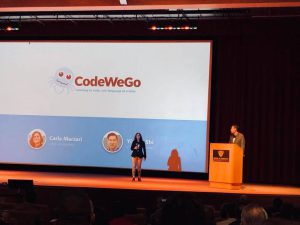 “The team has developed a scalable web application to assist non-English-speaking users to learn how to code using their native languages, including Spanish and Chinese. The project uses front-end framework React and Golang/Node programming languages,” Dr. Weiqing Sun, associate professor in the Department of Engineering Technology, said.
“The team has developed a scalable web application to assist non-English-speaking users to learn how to code using their native languages, including Spanish and Chinese. The project uses front-end framework React and Golang/Node programming languages,” Dr. Weiqing Sun, associate professor in the Department of Engineering Technology, said.
The exposition, which is free and open to the public, showcases projects created by more than 250 graduating seniors from the departments of Bioengineering; Civil and Environmental Engineering; Electrical Engineering and Computer Science; Engineering Technology; and Mechanical, Industrial and Manufacturing Engineering.
As part of these projects, students form business-consulting units to develop a solution for a client’s technical or business challenge. Businesses, industries and federal agencies sponsor the projects required for graduating seniors in the UT College of Engineering.
The expo also will showcase 12 freshman design projects and feature the High School Design Competition for area high school students from 10 a.m. to 2 p.m.
National science leader, Toledo native to deliver UT commencement address Dec. 15
Thursday, December 6th, 2018The head of the nation’s oldest and one of its most prestigious laboratories will return home, as Toledo native Dr. Michael Witherell delivers the keynote address during The University of Toledo’s undergraduate commencement ceremony Saturday, Dec. 15.
Witherell, director of the Lawrence Berkeley National Laboratory (Berkeley Lab) in Berkeley, Calif., will address 1,474 candidates for degrees, including 1,437 bachelor’s and 37 associate’s candidates. The event will take place at 11:30 a.m. in Savage Arena on UT’s Main Campus.
UT’s graduate commencement ceremony is scheduled at 8 a.m. in Savage Arena, and will commemorate 641 candidates for doctoral, education specialist and master’s degrees, as well as graduate certificates. Md Kamal Hossain, emerging cancer researcher and candidate for a doctoral degree at UT, is the keynote speaker.
Both fall commencement ceremonies are open to the public and can be viewed live at video.utoledo.edu.
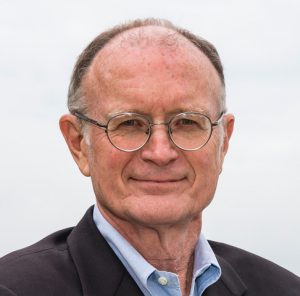
Dr. Michael Witherell
Witherell, a distinguished physicist, educator and science leader, developed the foundation for his future at Toledo’s St. Francis de Sales High School. Salutatorian at age 15, he earned a bachelor of science degree from the University of Michigan and a doctorate in experimental physics from the University of Wisconsin. After a distinguished career as a university professor performing research in particle physics, he devoted himself to leading large research institutions.
In 2016, Witherell was named director of Berkeley Lab, the oldest of the 17 labs in the U.S. Department of Energy national laboratories systems. The lab’s employees have earned 13 Nobel prizes and played a role in the discovery of 16 elements on the periodic table, among its honors.
“Our mission at Berkeley Lab is solving the nation’s most challenging problems through great scientific and technological discoveries. I believe that the national assets in addressing these problems include public universities and the students whom they are educating,” Witherell said.
Before joining Berkeley Lab, Witherell spent six years as director of the Fermi National Accelerator Laboratory in Illinois. He was vice chancellor for research at the University of California, Santa Barbara, where he also held a presidential chair in the Physics Department. His primary research interest is in studying the nature of dark matter.
Witherell is a Fellow of the American Physical Society, the American Association for the Advancement of Science and the American Academy of Arts and Sciences. He chairs the Board of Physics and Astronomy of the National Academies and serves on the National Academies’ Committee on Science, Engineering and Public Policy.
“As a nationally recognized, public research university, The University of Toledo is pleased to have Dr. Witherell as our fall commencement speaker. Research not only helps us to discover new knowledge that advances all areas of study, but also instills critical thinking skills that our students can use to approach problems systematically and come up with solutions that improve everyday life,” UT President Sharon L. Gaber said. “We look forward to Dr. Witherell sharing his insights with our graduates, especially since he grew up in Toledo and has since made tremendous contributions through research.”
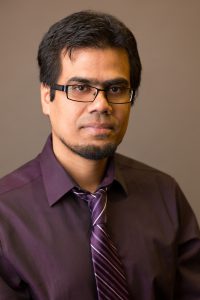
Md Kamal Hossain
Hossain, the graduate ceremony keynote speaker, is a native of Dhaka, Bangladesh, who came to UT as an industrial pharmacist with a passion to develop innovative medicines. He is a candidate for a doctor of philosophy degree in medicinal chemistry in UT’s College of Pharmacy and Pharmaceutical Sciences.
“I’ve always been interested in studying health-related fields due to the suffering of people in my homeland from different types of disease,” Hossain said. “My focus is to develop a specific targeting approach for a more effective cancer vaccine. My research examined the utilization of a natural antibody already present in human serum that makes the vaccine more convenient to target tumor cells.”
UT’s fall commencement ceremonies will recognize graduates from the colleges of Arts and Letters; Business and Innovation; Judith Herb College of Education; Engineering; Graduate Studies; Health and Human Services; Natural Sciences and Mathematics; Nursing; and Pharmacy and Pharmaceutical Sciences, as well as University College.
For more information, visit utoledo.edu/commencement.
Ritter Planetarium showing holiday programs on full dome for kids
Wednesday, December 5th, 2018The University of Toledo Ritter Planetarium is showing “The Alien Who Stole Christmas” and “Santa’s Secret Star” in full dome for children throughout the holiday season.
“The Alien Who Stole Christmas” is featured 7:30 p.m. on Friday, Dec. 14 and Friday, Dec. 21.
“Santa’s Secret Star” is featured 1 p.m. Saturday, Dec. 15 and Saturday, Dec. 22.
“These are amusing, entertaining and educational programs for children and Santa fans of all ages,” Alex Mak, associate director of UT Ritter Planetarium, said.
“Santa’s Secret Star” is a story about Santa and Rudolph learning how to find their way back to the North Pole using constellations. After Santa finishes his Christmas deliveries, he and his reindeer become lost. Without a compass, he and Rudolph turn to the constellations for help, and the stars lead them to the North Star, which guides them home.
“The Alien Who Stole Christmas” tells the story of Santa meeting Mr. Freep, an alien from another world. Together they head off on a cosmic adventure taking them to the farthest regions of the solar system and try to make it back in time for Santa to deliver toys to the children of Earth.
Admission to the programs is $7 for adults and $5 for children, senior citizens and UT community members. All children younger than four are free. Doors will open 30 minutes prior to the show.
Discovery of single material that produces white light could boost efficiency, appeal of LED bulbs
Tuesday, December 4th, 2018Physicists at The University of Toledo are part of an international team of scientists who discovered a single material that produces white light, opening the door for a new frontier in lighting, which accounts for one-fifth of global energy consumption.
“Due to its high efficiency, this new material can potentially replace the current phosphors used in LED lights – eliminating the blue-tinged hue – and save energy,” said Dr. Yanfa Yan, professor of physics at UT. “More research needs to be done before it can be applied to consumer products, but the ability to reduce the power that bulbs consume and improve the color quality of light that the bulbs emit is a positive step to making the future more environmentally friendly.”
The renewable energy research was recently published in Nature, the world’s leading multidisciplinary science journal.
The equation to make the inorganic compound combines a lead-free double perovskite with sodium.
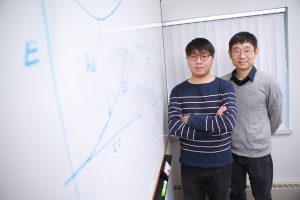
Dr. Xiaoming Wang, left, and Dr. Yanfa Yan, right.
“Together, cesium, silver, indium and chloride emit white light, but the efficiency is very low and not usable,” Yan said. “When you incorporate sodium, the efficiency increases dramatically. However, when sodium concentration reaches beyond 40 percent, side effects occur and the white light emission efficiency starts to drop below the peak of 86 percent.”
Supported by the U.S. Department of Energy’s Energy Frontier Research Center in Colorado known as CHOISE, Yan and Dr. Xiaoming Wang, UT post-doctoral researcher, conducted the theoretical calculations that revealed why the new material created through experiments by a team led by Dr. Jiang Tang at Huazhong University of Science and Technology in China produces high-efficiency white light.
“It was a wonderful experience working with Dr. Wang and Dr. Yan. Their professional theoretical simulation helps to reveal the emission mechanism of this miracle material,” said Tang, professor at Huazhong University of Science and Technology’s Wuhan National Laboratory. “This lead-free all-inorganic perovskite not only emits stable and efficient warm-white light that finds itself useful for solid-state lighting, but also shows as an encouraging example that lead-free perovskites could even show better performance than their lead cousins.”
“Their work is truly impressive,” Dr. Sanjay Khare, professor and chair of the UT Department of Physics and Astronomy, said. “Emission of white light from a single material is likely to open a whole new field in opto-electronics.”
Monash University, Jilin University, University of Toronto, Tsinghua University, Chinese Academy of Sciences and Wuhan University also contributed to the research.
Catholic studies lecture to address abuse in church
Monday, December 3rd, 2018“Abuse in the Church: A Night of Reckoning” is the topic of the annual Murray/Bacik Lecture in Catholic Studies, which will take place Wednesday, Dec. 5.
The talk begins at 7 p.m. in the Center for Performing Arts Recital Hall at The University of Toledo.
Dr. Peter Feldmeier, the Murray/Bacik Endowed Professor of Catholic Studies and chair of the UT Department of Philosophy, will deliver the lecture.
He said the lecture will examine the history of the Catholic sex abuse crisis in the 21st century, and how poorly the church has handled the allegations.
“It’s not going to be a slash job, but I’m not going to pull any punches either,” Feldmeier said. “I hope those who attend leave with a better understanding of the problem and a sense of hope for the church.”
Feldmeier has been at the University for seven years. He earned his PhD in Christian spirituality at the Graduate Theological Union in Berkeley, Calif., and his research areas of interest include Christian spirituality, comparative theology, Buddhist-Christian dialogue and religious mysticism.
He is a member of the Catholic Theological Society of America, the College Theology Society, the Society for the Study of Christian Spirituality, and the American Academy of Religion.
The lecture is free, but tickets are required; RSVP at the College of Arts and Letters website at utoledo.edu/al.
Free parking will be available in lots 12 and 12E by the Law Center and the Center for the Performing Arts.

